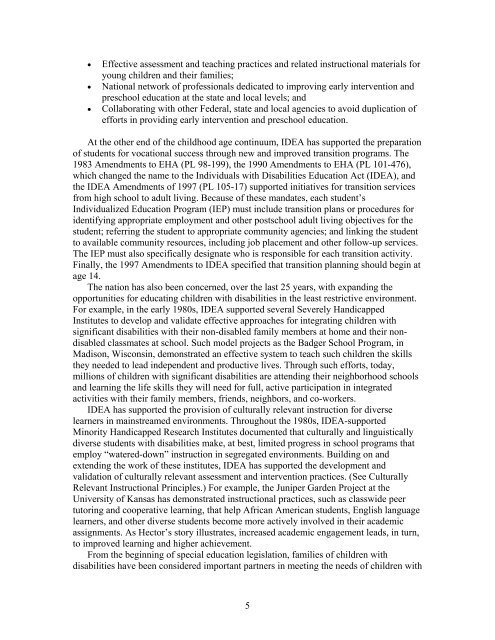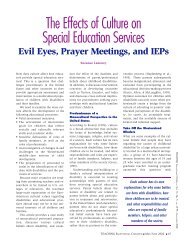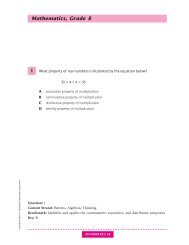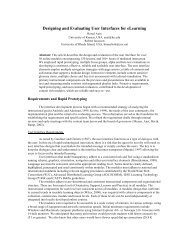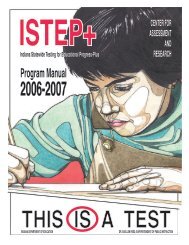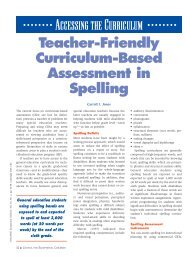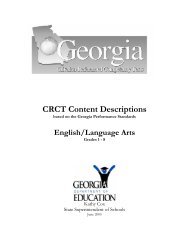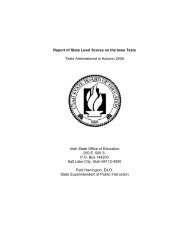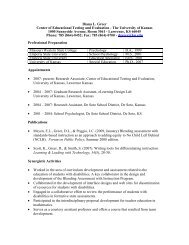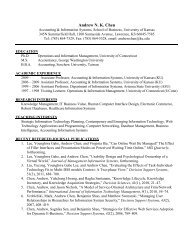Twenty-five years of progress in educating children with disabilities ...
Twenty-five years of progress in educating children with disabilities ...
Twenty-five years of progress in educating children with disabilities ...
Create successful ePaper yourself
Turn your PDF publications into a flip-book with our unique Google optimized e-Paper software.
• Effective assessment and teach<strong>in</strong>g practices and related <strong>in</strong>structional materials for<br />
young <strong>children</strong> and their families;<br />
• National network <strong>of</strong> pr<strong>of</strong>essionals dedicated to improv<strong>in</strong>g early <strong>in</strong>tervention and<br />
preschool education at the state and local levels; and<br />
• Collaborat<strong>in</strong>g <strong>with</strong> other Federal, state and local agencies to avoid duplication <strong>of</strong><br />
efforts <strong>in</strong> provid<strong>in</strong>g early <strong>in</strong>tervention and preschool education.<br />
At the other end <strong>of</strong> the childhood age cont<strong>in</strong>uum, IDEA has supported the preparation<br />
<strong>of</strong> students for vocational success through new and improved transition programs. The<br />
1983 Amendments to EHA (PL 98-199), the 1990 Amendments to EHA (PL 101-476),<br />
which changed the name to the Individuals <strong>with</strong> Disabilities Education Act (IDEA), and<br />
the IDEA Amendments <strong>of</strong> 1997 (PL 105-17) supported <strong>in</strong>itiatives for transition services<br />
from high school to adult liv<strong>in</strong>g. Because <strong>of</strong> these mandates, each student’s<br />
Individualized Education Program (IEP) must <strong>in</strong>clude transition plans or procedures for<br />
identify<strong>in</strong>g appropriate employment and other postschool adult liv<strong>in</strong>g objectives for the<br />
student; referr<strong>in</strong>g the student to appropriate community agencies; and l<strong>in</strong>k<strong>in</strong>g the student<br />
to available community resources, <strong>in</strong>clud<strong>in</strong>g job placement and other follow-up services.<br />
The IEP must also specifically designate who is responsible for each transition activity.<br />
F<strong>in</strong>ally, the 1997 Amendments to IDEA specified that transition plann<strong>in</strong>g should beg<strong>in</strong> at<br />
age 14.<br />
The nation has also been concerned, over the last 25 <strong>years</strong>, <strong>with</strong> expand<strong>in</strong>g the<br />
opportunities for educat<strong>in</strong>g <strong>children</strong> <strong>with</strong> <strong>disabilities</strong> <strong>in</strong> the least restrictive environment.<br />
For example, <strong>in</strong> the early 1980s, IDEA supported several Severely Handicapped<br />
Institutes to develop and validate effective approaches for <strong>in</strong>tegrat<strong>in</strong>g <strong>children</strong> <strong>with</strong><br />
significant <strong>disabilities</strong> <strong>with</strong> their non-disabled family members at home and their nondisabled<br />
classmates at school. Such model projects as the Badger School Program, <strong>in</strong><br />
Madison, Wiscons<strong>in</strong>, demonstrated an effective system to teach such <strong>children</strong> the skills<br />
they needed to lead <strong>in</strong>dependent and productive lives. Through such efforts, today,<br />
millions <strong>of</strong> <strong>children</strong> <strong>with</strong> significant <strong>disabilities</strong> are attend<strong>in</strong>g their neighborhood schools<br />
and learn<strong>in</strong>g the life skills they will need for full, active participation <strong>in</strong> <strong>in</strong>tegrated<br />
activities <strong>with</strong> their family members, friends, neighbors, and co-workers.<br />
IDEA has supported the provision <strong>of</strong> culturally relevant <strong>in</strong>struction for diverse<br />
learners <strong>in</strong> ma<strong>in</strong>streamed environments. Throughout the 1980s, IDEA-supported<br />
M<strong>in</strong>ority Handicapped Research Institutes documented that culturally and l<strong>in</strong>guistically<br />
diverse students <strong>with</strong> <strong>disabilities</strong> make, at best, limited <strong>progress</strong> <strong>in</strong> school programs that<br />
employ “watered-down” <strong>in</strong>struction <strong>in</strong> segregated environments. Build<strong>in</strong>g on and<br />
extend<strong>in</strong>g the work <strong>of</strong> these <strong>in</strong>stitutes, IDEA has supported the development and<br />
validation <strong>of</strong> culturally relevant assessment and <strong>in</strong>tervention practices. (See Culturally<br />
Relevant Instructional Pr<strong>in</strong>ciples.) For example, the Juniper Garden Project at the<br />
University <strong>of</strong> Kansas has demonstrated <strong>in</strong>structional practices, such as classwide peer<br />
tutor<strong>in</strong>g and cooperative learn<strong>in</strong>g, that help African American students, English language<br />
learners, and other diverse students become more actively <strong>in</strong>volved <strong>in</strong> their academic<br />
assignments. As Hector’s story illustrates, <strong>in</strong>creased academic engagement leads, <strong>in</strong> turn,<br />
to improved learn<strong>in</strong>g and higher achievement.<br />
From the beg<strong>in</strong>n<strong>in</strong>g <strong>of</strong> special education legislation, families <strong>of</strong> <strong>children</strong> <strong>with</strong><br />
<strong>disabilities</strong> have been considered important partners <strong>in</strong> meet<strong>in</strong>g the needs <strong>of</strong> <strong>children</strong> <strong>with</strong><br />
5


